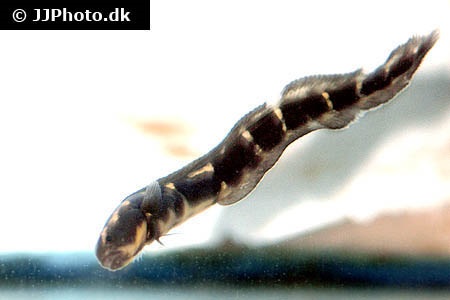Pholidichthys leucotaenia
| Latin name | Pholidichthys leucotaenia - Bleeker, 1856 |
|---|---|
| Local name | Convict blenny |
| Family | Pholidichthyidae - Pholidichthys |
| Origin | Australia, Indonesia, Central/West Pacific |
| Max length | 34 cm (13.4") |
| Minimum volume |
400 l (106 gal) |
|---|---|
| Hardiness |
Hardy |
| Suitable for aquarium |
Suitable with care |
| Reef safe |
Reef safe with caution |
| Aggressiveness | Mostly peaceful but might be aggressive towards similar species |
| Recommended |
Fish Larger crustaceans (Shrimp, crabs...) Small crustaceans (Krill, mysis, artemia...) |
|---|
This spicies might be a threat to smaller fishes.
This species poses a threat towards shrimps and crabs etc., which are relatively small.
This species likes rearranging the sand in the aquarium.
Be sure that the rocks cannot collapse if the sand is removed.
This fish requires feeding several times a day, especially when newly added.
When the fish can find its natural food in the aquarium it requires less frequent feeding.
They can live as a pair provided they are introduced simultaneously.
This species needs good hiding places, for example, between live rocks.
This species can be bred in captivity, one can therefore consider asking your local fish store for a captive bred specimen.
When young these fish have horizontal stripes, but as they grow, the pattern changes and the stripes become more vertical.
Should be kept in an aquarium where there is enough sand for it to make a small cave.
Convict Blennies (Pholidichthydiae) live in small holes in the sand and rocks. At first they live on only zooplankton, but as they become larger they also start eating fish and crustaceans.
Provided with the right environment these fish are a nice and unique addition to an aquarium.
One should be aware that these fish dig into the bottom so that sand and debris whirls around in a tank.
If one wishes an aquarium where the debris does not accumulate in one place, this is the obvious choice.
| Aquarium trade | Yes |
|---|---|
| Distribution | Western Central Pacific: Philippines south to the Solomon Islands. Absent from Australia. |
| Danish common names |
Fangedragtsslimfisk |
| English common names |
Convict blenny |
Scott W. Michael. Reef Aquarium Fishes: 500+ Essential-to-know Species - TFH Publications / Microcosm Ltd. - (English)
Bob Fenner. Convict Blennies, Family Pholidichthyidae - Wet Web Media - (English)




